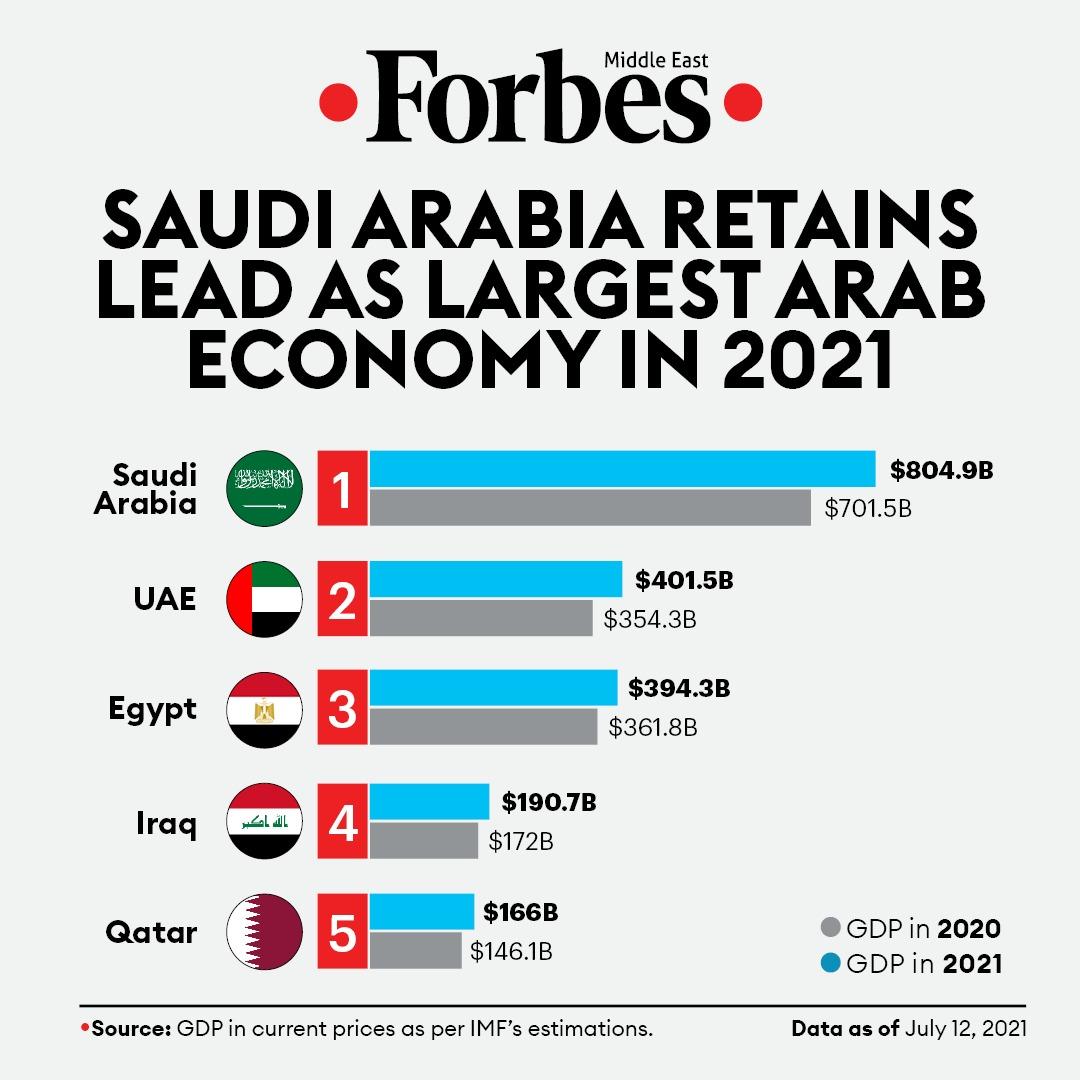Arab countries have prominent positions in the global economy, not only as providers of oil and petroleum-derived products but also as top-world investors in high-tech companies. The future of the global economy is going to change following the trends from regional economies.
Currently, Saudi Arabia’s gross domestic product (GDP) of $701.5 billion in 2020 makes market experts feel confident in forecasting a continuation of the trend with numbers reaching over $800 billion by the end of 2021.
The Wealthiest Economies In The MENA Region
A recent report from the International Monetary Fund (IMF) in April 2021, revealed that UAE’s GDP is projected to overtake Egypt by the end of 2021. This would put the UAE’s total GDP in the second position on the list of the leading economies of the MENA region. The projection estimates an increase from $354.3 billion in 2020 to $401.5 billion in 2021.
Egypt is expected to take the third position in the region with GDP estimated to grow to $394.3 billion in 2021. This is a significant increase from $361.8 billion in 2020. Iraq will maintain its position on the fourth spot with an estimated GDP of $190.7 billion in 2021, compared to $197.12 billion in 2020.
The fifth position in the list of the leading economies in the MENA region is Qatar. This country won’t step up the ranking position from last year despite its GDP increasing from $146.1 billion in 2020 to $166 billion in 2021. Although Qatar will stay in the same position on the list this year, it still maintains one of the highest GDP per capita in the region. That is due to low population density along with a high economic output relative to the physical size of the country.
Trends in MENA’s Largest Economies
Arab Financials provides updates and analysis of the most recent economic news in the Middle East. Analysis and comparison of historic trends in the region can offer many insights into possible future results.
Saudi Arabia
The Kingdom of Saudi Arabia stands out in the MENA region for its significant efforts in boosting digital transformation activities. The best examples of this are the move towards more digitally accessible government and financial services. The political reforms of the Kingdom focus on efforts to grow globally competitive industries. The focus has been on telecommunication, automation, technology, and financial services but there are plans to expand into other industries as well. Saudi Arabia’s government decided to make large investments in non-oil sectors in the second half of 2020. This is a trend that will continue in 2021 and the future. However, per-capita growth of the Kingdom’s GDP is below the past levels: $23,300 in 2019 to $22,700 in 2021. Unemployment levels have dramatically declined from 2019 to 2021 which should cause more significant per-capita GDP growth in the future.
In general, Saudi Arabia’s economy appears to be flourishing. It is well-supported by both the government and private sectors in key industries such as banking/financial services, high-tech innovations, cryptocurrency services, and internet security.
United Arab Emirates
According to the IMF, the Emirates’ real GDP might grow by 3.1% in 2021, after the “black” period of the pandemic. Also, the UAE’s per capita GDP numbers look to be on the right path to reach $35,200 in 2021; up from $ 31,900 in 2020. It is important to note that the pre-pandemic levels were still higher than the actual forecast ($39,200 in 2019).
Jihad Azour, Director of the Middle East and Central Asia Department at the IMF, reveals that the UAE’s economy reacted excellently to the pandemic bringing positive consequences on the GDP growth. Also, Mr. Azour notes that the Emirates’ economy is focusing on developing the technology sectors in order to diversify the local economic pattern and, at the same time, to boost recovery after the pandemic.
Egypt
The economic reforms of 2016 helped Egypt maintain a balance between national spending and financial sustainability during the pandemic. The IMF expects Egypt’s economy to grow its GDP by 2.8%, though there’s still a margin of uncertainty behind these expectations. The current public debt of the country combined with the fiscal needs could impede Egypt from reaching the expected GDP growth level. Egypt has allocated $6.13 billion (corresponding to 1.8% of its GDP) to assist recovery post pandemic. The government adopted several measures to support workers, especially in the most pandemic-impacted sectors.
Within this framework, Egypt’s GDP per capita will continue its positive trend by an increase of 6.8% in 2021.
These three Arab countries not only represent the fast-growing side of the MENA region, though they also stand for the potential future leading economies of the world. Many questions remain on the specifics of recovery, but the region, as a whole, appears to be poised for growth.
⚠ Article Disclaimer
The above article is sponsored content any opinions expressed in this article are those of the author and not necessarily reflect the views of CTN News








